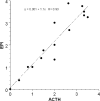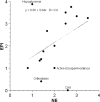Adrenomedullary, adrenocortical, and sympathoneural responses to stressors: a meta-analysis
- PMID: 18999898
- PMCID: PMC5522726
Adrenomedullary, adrenocortical, and sympathoneural responses to stressors: a meta-analysis
Abstract
Objective: Exposure to stressors alters activities of the adrenomedullary hormonal system (AHS), hypothalamic-pituitary-adrenocortical (HPA) axis, and sympathetic nervous system (SNS). Here we report results of a meta-analysis of the literature, examining inter-relationships among AHS, HPA, and SNS responses to stressors, as measured by plasma epinephrine (EPI), corticotrophin (ACTH), and norepinephrine (NE) levels.
Methods: The medical scientific literature was culled by PubMed searches, to retrieve publications describing original data about plasma EPI, ACTH, and NE levels measured before and during or after exposure to stressors. Magnitudes of responses were graded from a score of 0 for no response to 4 for a massive increase to >or=10 times the baseline value.
Results: A total of 15 stressors were identified for which at least 2 publications reported data for EPI, ACTH, and NE responses. A total of 60 reports were included. Mean EPI responses were strongly positively correlated with mean ACTH responses (r=0.93) and less strongly with NE responses (r=0.40). Plasma EPI responses were disproportionately larger than NE responses during hypoglycemia and smaller than NE responses during cold exposure without hypothermia, orthostasis, and active escape/avoidance. Plasma NE responses were disproportionately larger than ACTH responses during cold exposure without hypothermia and severe/exhausting exercise and smaller than ACTH responses during hypoglycemia.
Discussion: The results of this meta-analysis indicate a close association between adrenomedullary and hypothalamic-pituitary-adrenocortical responses across a variety of stressors. This association seems to be if anything stronger than that between adrenomedullary and sympathetic noradrenergic responses.
Figures



Similar articles
-
Role of CRH in glucopenia-induced adrenomedullary activation in rats.J Neuroendocrinol. 1993 Oct;5(5):475-86. doi: 10.1111/j.1365-2826.1993.tb00511.x. J Neuroendocrinol. 1993. PMID: 8680414
-
Effects of various stressors on in vivo norepinephrine release in the hypothalamic paraventricular nucleus and on the pituitary-adrenocortical axis.Ann N Y Acad Sci. 1995 Dec 29;771:115-30. doi: 10.1111/j.1749-6632.1995.tb44675.x. Ann N Y Acad Sci. 1995. PMID: 8597392
-
Lower adrenocortical and adrenomedullary responses to hypoglycemia in premenopausal women with systemic sclerosis.J Rheumatol. 2006 Nov;33(11):2235-41. J Rheumatol. 2006. PMID: 17086608
-
Stress-induced norepinephrine release in the hypothalamic paraventricular nucleus and pituitary-adrenocortical and sympathoadrenal activity: in vivo microdialysis studies.Front Neuroendocrinol. 1995 Apr;16(2):89-150. doi: 10.1006/frne.1995.1004. Front Neuroendocrinol. 1995. PMID: 7621982 Review.
-
Aging is associated in the 344/N Fischer rat with decreased stress responsivity of central and peripheral catecholaminergic systems and impairment of the hypothalamic-pituitary-adrenal axis.Ann N Y Acad Sci. 1995 Dec 29;771:491-511. doi: 10.1111/j.1749-6632.1995.tb44705.x. Ann N Y Acad Sci. 1995. PMID: 8597425 Review.
Cited by
-
Dependence of Seasonal Dynamics in Healthy People's Circulating Lipids and Carbohydrates on Regional Climate: Meta-Analysis.Indian J Clin Biochem. 2022 Oct;37(4):381-398. doi: 10.1007/s12291-022-01064-6. Epub 2022 Aug 5. Indian J Clin Biochem. 2022. PMID: 36262777 Free PMC article. Review.
-
Overtraining Syndrome as a Complex Systems Phenomenon.Front Netw Physiol. 2022 Jan 18;1:794392. doi: 10.3389/fnetp.2021.794392. eCollection 2021. Front Netw Physiol. 2022. PMID: 36925581 Free PMC article. Review.
-
Basal and Stress-Induced Network Activity in the Adrenal Medulla In Vivo.Front Endocrinol (Lausanne). 2022 Jun 20;13:875865. doi: 10.3389/fendo.2022.875865. eCollection 2022. Front Endocrinol (Lausanne). 2022. PMID: 35795145 Free PMC article.
-
Evidence for discrete profiles of children's physiological activity across three neurobiological system and their transitions over time.Dev Sci. 2021 Jan;24(1):e12989. doi: 10.1111/desc.12989. Epub 2020 May 28. Dev Sci. 2021. PMID: 32416021 Free PMC article.
-
Stress hormone synthesis in mouse hypothalamus and adrenal gland triggered by restraint is dependent on pituitary adenylate cyclase-activating polypeptide signaling.Neuroscience. 2010 Feb 17;165(4):1025-30. doi: 10.1016/j.neuroscience.2009.11.023. Epub 2009 Nov 18. Neuroscience. 2010. PMID: 19931358 Free PMC article.
References
-
- Ayala AR, Pushkas J, Higley JD, Ronsaville D, Gold PW, Chrousos GP, Pacak K, Calis KA, Gerald M, Lindell S, Rice KC, Cizza G. Behavioral, adrenal, and sympathetic responses to long-term administration of an oral corticotropin-releasing hormone receptor antagonist in a primate stress paradigm. J Clin Endocrinol Metab. 2004;89:5729–5737. - PubMed
-
- Bereiter DA, Zaid AM, Gann DS. Effect of rate of hemorrhage on sympathoadrenal catecholamine release in cats. Am J Physiol. 1986;250:E69–E75. - PubMed
-
- Berkenbosch F, De Goeij DE, Rey AD, Besedovsky HO. Neuroendocrine, sympathetic and metabolic responses induced by interleukin-1. Neuroendocrinology. 1989;50:570–576. - PubMed
-
- Cannon WB, Lissak K. Evidence for adrenaline in adrenergic neurones. Am. J. Physiol. 1939;125:765–777.
-
- Carroll JF, Wood CE, Pollock ML, Graves JE, Convertino VA, Lowenthal DT. Hormonal responses in elders experiencing pre-syncopal symptoms during head-up tilt before and after exercise training. J Gerontol A Biol Sci Med Sci. 1995;50:M324–M329. - PubMed
Publication types
MeSH terms
Substances
Grants and funding
LinkOut - more resources
Full Text Sources
